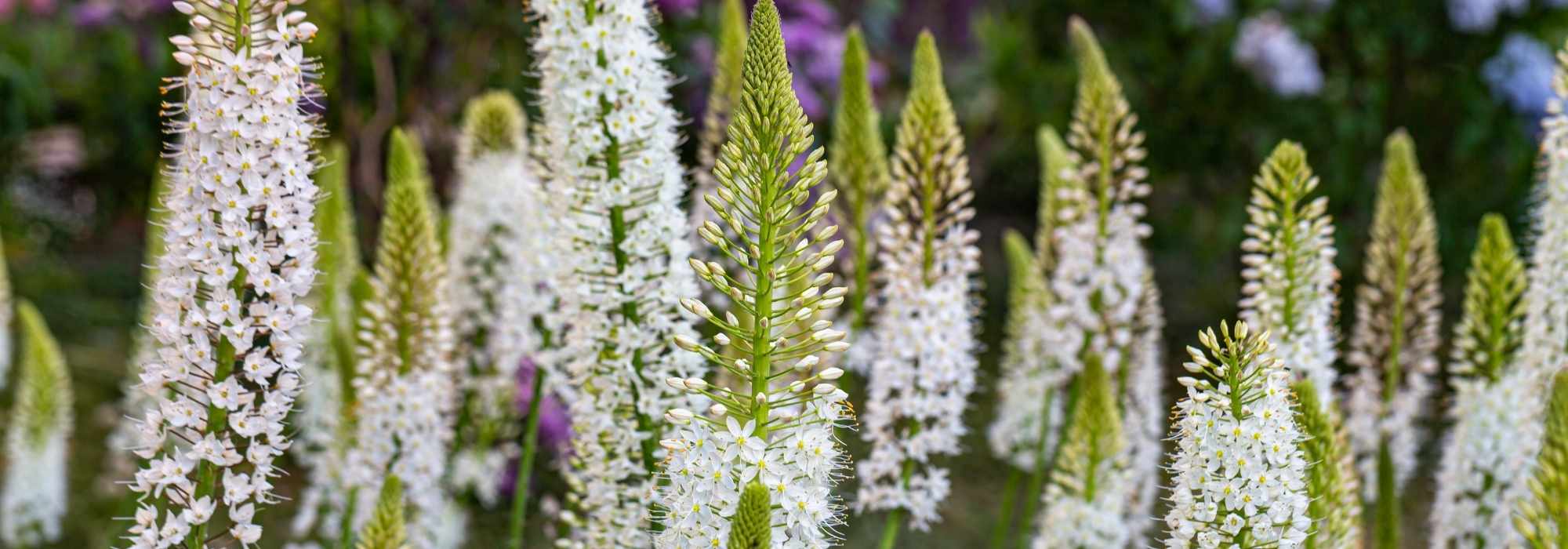
Eremurus - Foxtail lily: planting and growing
Contents
Foxtail lilies in a few words
- Eremurus are perennials with fleshy roots sold as bulbs
- Steppe lilies flower in late spring or early summer in shades of white, pink, yellow, or orange
- Some flower spikes of desert lilies can grow over 2 metres tall
- Very hardy, steppe lilies thrive in full sun and well-drained soil
- Eremurus look stunning in borders, rockeries, but can also be grown in pots
The word from our expert
Whether you love them or not, it’s undeniable that Foxtail Lilies are… effective perennials. Simply put, when in full flowering, they dominate any flowerbed with their gigantic flower spikes, sometimes reaching up to two metres tall, covered in small star-shaped white, pink, yellow, or orange flowers. The colour of the flowers and the height of the spike depend on the botanical species or horticultural cultivar.
Foxtail Lilies live up to their name, as they are flowering plants from the Liliaceae family, native to the meadows and steppes of Asia. Their ideal conditions include: plenty of sun, distinct seasons with cold winters, relatively low rainfall, and rich, well-drained soil. With this knowledge, you have all the keys to successfully grow Eremurus.
Be warned, though—while Eremurus are easy to care for in the garden, they dislike two things: being moved, so choose their location carefully, and heavy soils that retain too much water in winter. Improve drainage by adding a generous amount of gravel at planting time.
I emphasised “perennial” at the start of this introduction because, although sold among bulbs, Cleopatra’s Needles (don’t laugh—it’s one of the many names for this perennial) are not bulbs. They are indeed peculiar plants when purchased: a large central bud surrounded by thick, sprawling roots, giving the whole thing the appearance of a dried octopus or some extraterrestrial oddity. Not the most inviting sight, but look past that first impression—plant them, and you won’t regret it!

Eremurus stenophyllus and Salvia nemorosa
Botany and description
Botanical data
- Latin name Eremurus sp.
- Family Liliaceae
- Common name Foxtail lily, Desert candle
- Flowering May to July
- Height up to 3 m
- Exposure sun
- Soil type fertile and fresh, but well-drained
- Hardiness -15°C
The genus Eremurus belongs to the Liliaceae family (formerly classified in the Asphodelaceae) and includes around sixty species. Among these, we can mention Eremurus robustus, the tallest with pale pink flower spikes, Eremurus himalaicus, native to the Himalayas with pure white flowers, Eremurus bungeï (syn: Eremurus stenophyllus), smaller with bright yellow flowers, Eremurus aitchisonii (syn: Eremurus elwesii), an Afghan species with light pink flowers, Eremurus olgae, with white flowers tinged with pink and fragrant, and Eremurus spectabilis, a foxtail lily with yellow flowers found from Turkey to Pakistan. In addition to the botanical species, many horticultural cultivars have been developed.
The Eremurus, or foxtail lilies or desert candles, grow in the cold high plains of Asia as far as Crimea. The foxtail lilies are sometimes also called Cleopatra’s needle or Cleopatra’s spindle. The Eremurus grow in rocky meadows and steppes of Asia, in the sun but sheltered from cold winds.
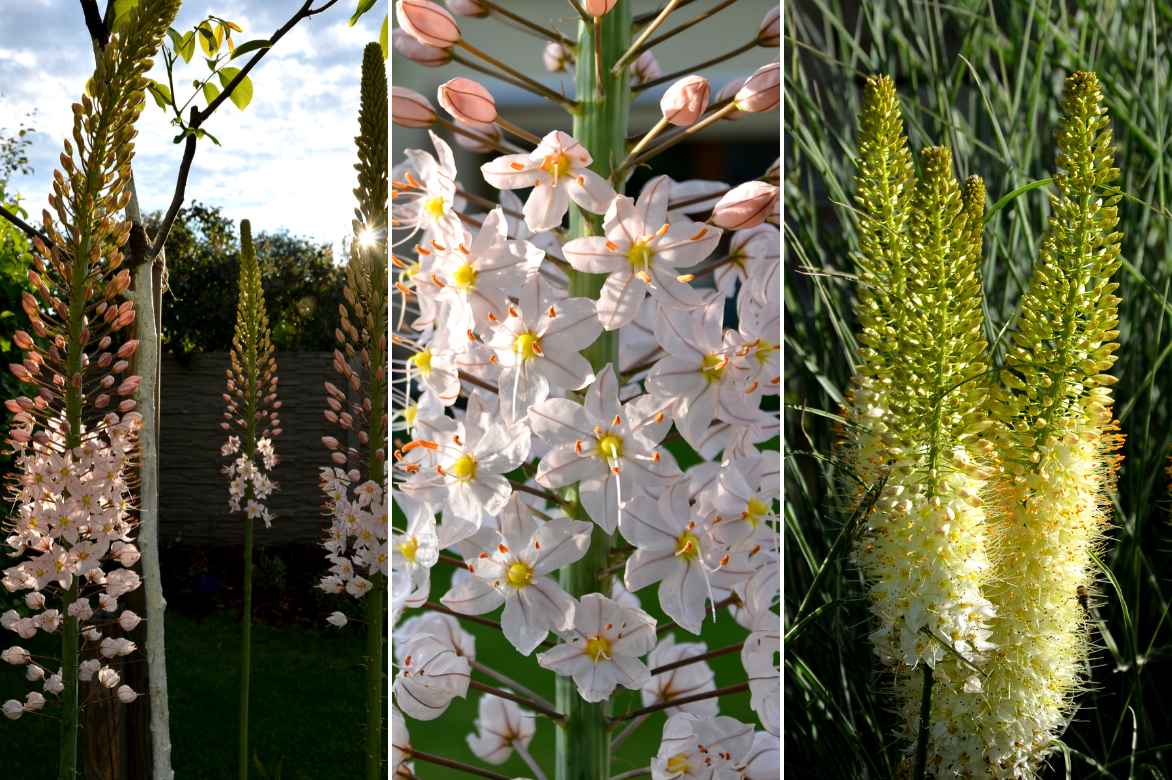
Eremurus robustus on the left and in the middle, and Eremurus stenophyllus on the right
In their natural range, the Eremurus, plants of cold to temperate climates, are protected from the cold by a layer of snow. In our gardens, these perennials prove hardy enough to remain in the ground during winter. However, it is essential to provide them with well-drained soil.
These are perennials with fleshy roots, commonly sold among bulbs. These long, fleshy roots are arranged around a central bud, giving the stump a strange octopus-like appearance. This central bud acts as a storage organ. This is why Eremurus are classified among bulbous plants in commerce.
The plant forms a rosette of strap-like leaves. Each leaf can measure up to 1 metre in length. The green foliage is lush but low, further highlighting the tall flower stem. Moreover, the leaves are deciduous and already begin to dry out at the start of flowering. The plant will then go dormant after flowering, from August onwards.

The Eremurus begins its leaf growth, and the “bulb” resembling a starfish
The summer flowering (from May to July, depending on the species) is spectacular, with the flower spike reaching up to 3 m in height for Eremurus robustus in its natural habitat. The flower spikes of Eremurus will often be shorter in our gardens, still reaching nearly 2 m for the tallest. These flower spikes bear hundreds of white, pink, yellow, or orange flowers that bloom from the bottom upwards, ensuring a flowering period spread over several weeks. Each of these small flowers is star-shaped with 5 petals and prominent stamens.
Note that Eremurus can sometimes take time to flower. So don’t be surprised if you don’t get flower spikes in the first year.
The flower spikes are used in bouquets and floral art in general.
Our favourite varieties
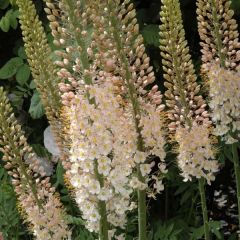
Eremurus robustus - Foxtail Lily
- Flowering time June, July
- Height at maturity 2,50 m
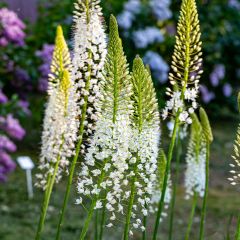
Eremurus himalaïcus - Foxtail Lily
- Flowering time June, July
- Height at maturity 2 m
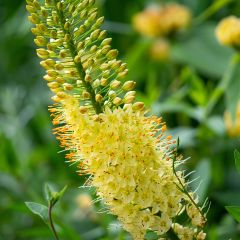
Eremurus bungei - Foxtail Lily
- Flowering time June, July
- Height at maturity 90 cm
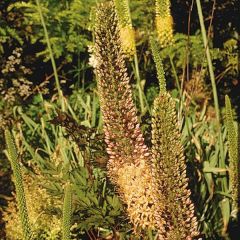
Eremurus Brun - Foxtail Lily
- Flowering time July, August
- Height at maturity 2 m

Eremurus isabellinus Cleopatra - Foxtail Lily
- Flowering time June, July
- Height at maturity 1,30 m
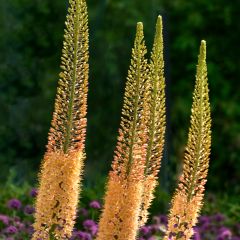
Eremurus stenophyllus Moneymaker - Foxtail Lily
- Flowering time July, August
- Height at maturity 1,50 m
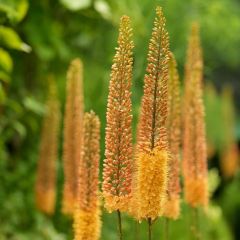
Eremurus isabellinus Pinokkio - Foxtail Lily
- Flowering time July, August
- Height at maturity 90 cm
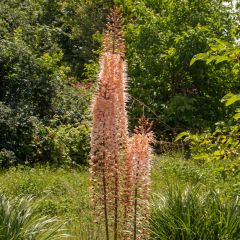
Eremurus Romance - Foxtail Lily
- Flowering time July, August
- Height at maturity 1,20 m

Eremurus x isabellinus Shelford' s Hybrids Tap Dance
- Flowering time July, August
- Height at maturity 1,50 m

Eremurus White Beauty Favourite - Foxtail Lily
- Flowering time June, July
- Height at maturity 1,30 m
Discover other Eremurus - Foxtail Lily
View all →Available in 0 sizes
Available in 2 sizes
Available in 2 sizes
Available in 1 sizes
Available in 1 sizes
Available in 1 sizes
Available in 1 sizes
Available in 1 sizes
Available in 1 sizes
Available in 1 sizes
Planting the Eremurus
Where to Plant?
Eremurus plants thrive in very sunny locations, sheltered from strong winds that could break their flower spikes. A south-facing spot will be perfect.
Steppe lilies absolutely require well-drained soil, otherwise the “bulb” may rot in winter. Unless your soil is naturally well-draining (sandy substrate and sloping terrain), you will need to improve drainage.
Indeed, Eremurus dislikes heavy, clayey soils, as these retain moisture in winter, which its bulbs cannot tolerate.
Eremurus can tolerate poor soils but prefers rich ones. Add some well-rotted compost at planting time. Additionally, it handles chalky soils quite well.
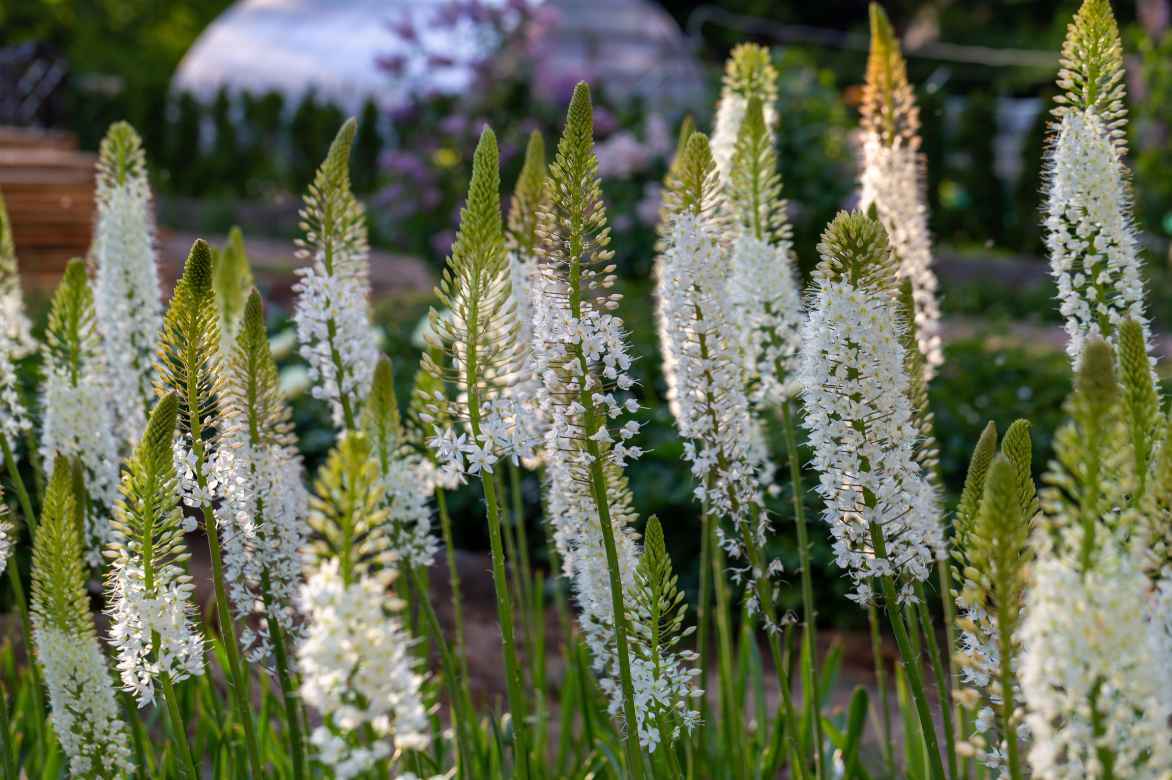
Eremurus himalaicus
When to Plant?
Plant your Eremurus in autumn, ideally around October. However, it is still possible to plant them in early winter, up until December or even January.
How to Plant?
In the ground:
As a reminder, Eremurus bulbs consist of a central bud from which thick roots extend, resembling “tentacles.” If some of these “tentacles” on your Eremurus are broken or damaged: don’t worry! These are just remnants of the previous year’s roots and serve only to stabilise the new flower spike during its early growth.
- Dig a wide hole, 15 cm deep;
- Loosen the soil and add a layer of gravel, 5 to 10 cm thick, to prevent waterlogging;
- Place the bulb directly on this drainage layer, with the bud facing upwards;
- Cover the bulb with about 8 cm of a mixture of compost, garden soil, and coarse sand: Eremurus will thrive much better in fairly rich, well-amended soil;
- Firm the soil and water lightly.
Warning!: Eremurus hate being moved. Choose their location carefully. Allow a spacing of 60 cm to 1 m, depending on the height of the chosen varieties. Don’t hesitate to plant steppe lilies in groups of 3 or 5 bulbs to create beautiful clumps.
In pots:
- Choose a sufficiently large pot, with a minimum diameter of 40 centimetres for taller varieties and 30 centimetres for shorter ones.
- Add a drainage layer of gravel and sand at the bottom of the pot.
- Fill with a mixture of sand, compost, and potting soil.
- Place the bulb with the roots curving downwards.
- Cover with 8 cm of soil.
- Water lightly.
In pots, the substrate dries out faster than in the ground. We recommend watering, but sparingly, when the soil is dry to the touch on the surface.
Maintenance
Eremurus require almost no maintenance. They can easily overwinter in the ground in well-drained soil.
Watering
They tolerate drought well but dislike excess moisture. However, they do need some watering in spring, especially if grown in pots. Water sparingly if the spring is very dry.
Maintenance
We recommend cutting the flower spike after flowering. This prevents the plant from exhausting itself by producing seeds.
You may need to stake the tallest varieties, particularly if planted in a windy area.
Eremurus is a greedy plant that thrives in rich soil, so don’t hesitate to add compost by raking it in during spring.
Possible diseases and pests
The steppe lily, when grown under the right conditions (sun and well-drained soil), is not susceptible to any diseases.
However, slugs are fond of the young leaves and the roots can fall prey to rodents, and its leaves may be devoured by slugs. From the moment of planting, surround the root with wire mesh to protect it from the appetite of rodents.
→For effective and natural ways to combat slugs, here are 7 handy tips.
Multiplying Your Steppe Lilies
By Dividing Clumps
Steppe Lilies propagate well by dividing clumps every 3 to 5 years. On older stumps with several visible buds:
- Cut the flower spikes when the foliage begins to wilt;
- Lift the stump using a garden fork and remove it from the soil. Be careful to dig into the soil with the fork’s tines far enough from the stump to avoid damaging it;
- Use a knife to trim any broken roots and separate the Eremurus claws with the same tool. Each “claw” should have one or more buds;
- Replant your Eremurus in loose soil and in a sunny spot.
By Sowing
Sowing seeds in autumn is theoretically possible but unpredictable. Additionally, the bulbs will take several years (sometimes up to 6 years) before they start to flower. If you wish to give it a try, you will need to sow your seeds in autumn under a cold frame in a very well-draining substrate (such as sand). The seedlings will appear in spring, at which point you can transplant them into pots, still in a very well-draining substrate, and keep them throughout the season before planting them in the ground in autumn. During the pot-growing phase, keep the substrate moist but not overly wet.
How to pair Eremurus?
The vertical dimension provided by Eremurus helps structure a somewhat flat perennial or bush border, adding height and breaking the monotony. The warmth of the flowers also helps revive a dull border or creates a pleasant contrast with bluish tones.
In a border designed with gravel and full sun, Eremurus will thrive. Consider, for example, Eremurus ‘Cleopatra’. You could opt for a composition full of contrasts with blue, purple, and yellow-orange flowers by pairing it with the globular forms of Allium christophii, the blue umbels of Agapanthus ‘Navy Blue’, and the Nepeta x faasseni ‘Purrsian Blue’. Don’t hesitate to combine yellow or orange steppe lilies with yellow Russell’s phlomis or Mullein, Verbascum bombyciferum ‘Polarsommer’, and Eryngium bourgatii.
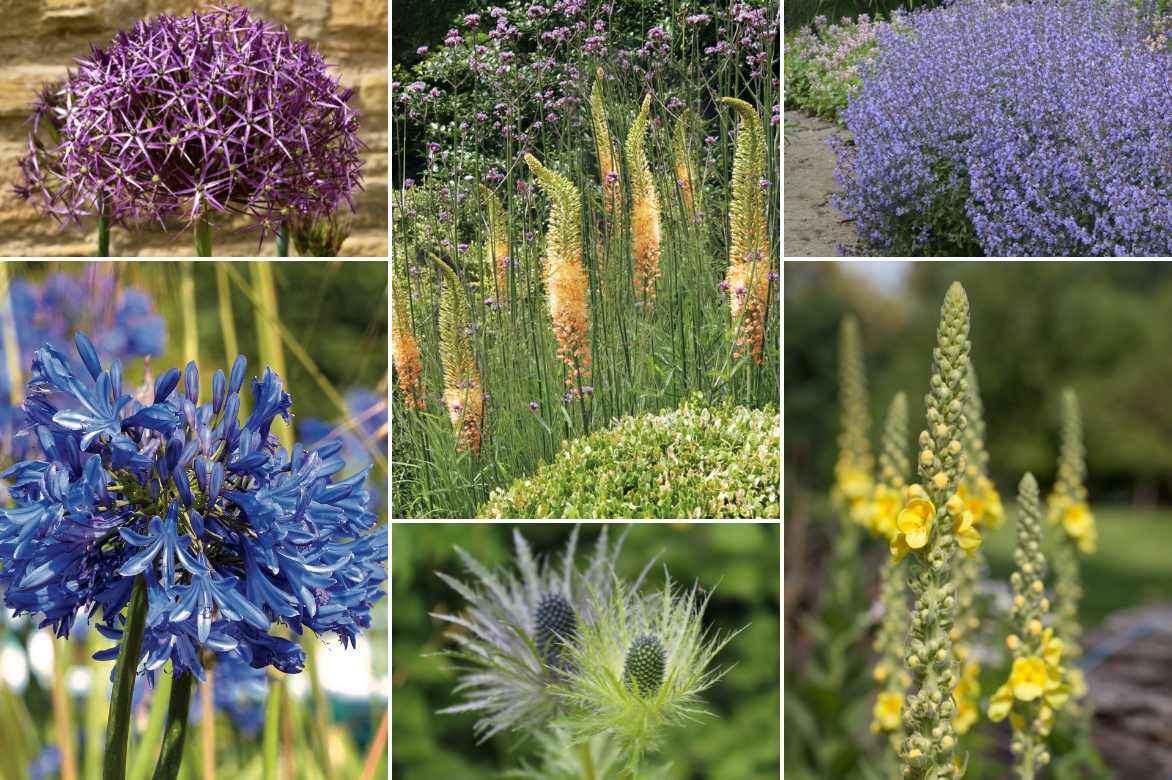
In the centre, Eremurus ‘Cleopatra’, surrounded by Allium christophii, Agapanthus ‘Navy Blue’, Eryngium, Nepeta faasseni ‘Purrsian Blue’, and Verbascum
For a more contemporary and graphic style, you could opt for the immense ivory-white spikes of Eremurus ‘White Beauty Favourite’. To accompany it, choose graphic plants in white tones, such as Eryngium yuccifolium, a striking eryngo with small round white flowers, Veronicastrum virginicum var. album, Agapanthus ‘White Heaven’, or even Kniphofia ‘Ice Queen’ with its poker-like blooms in varying shades of white.
Also worth reading...
Discover our magnificent Eremurus in our online nursery.
- Subscribe!
- Contents






































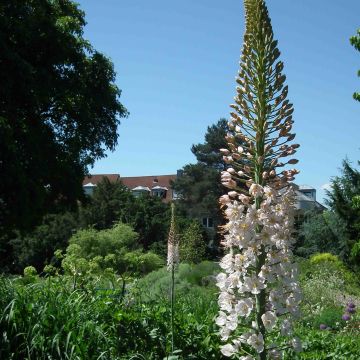


Comments